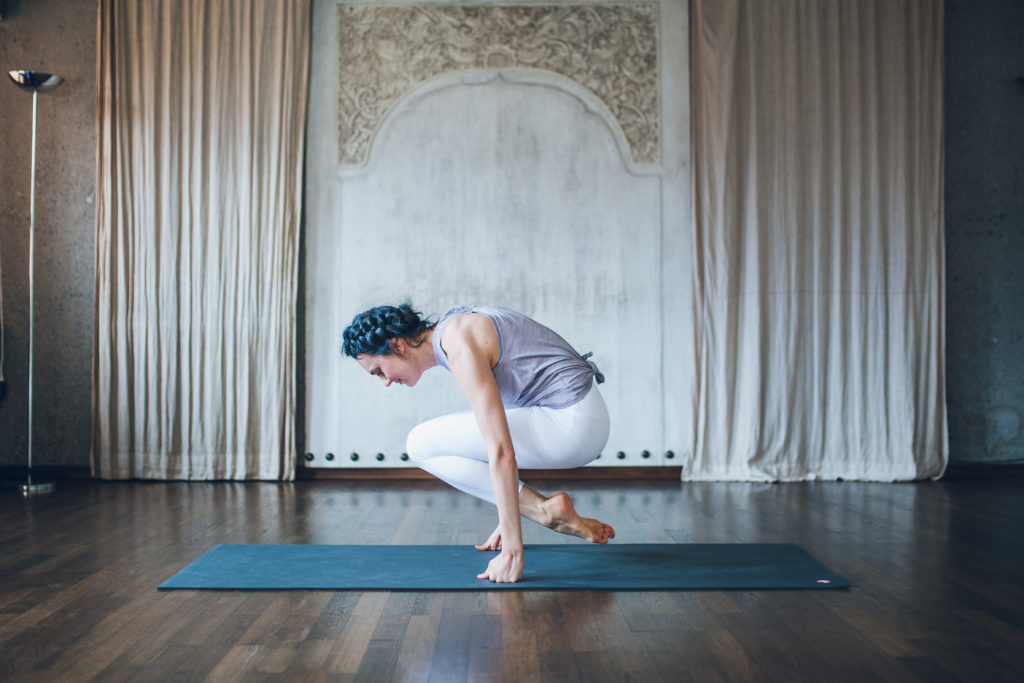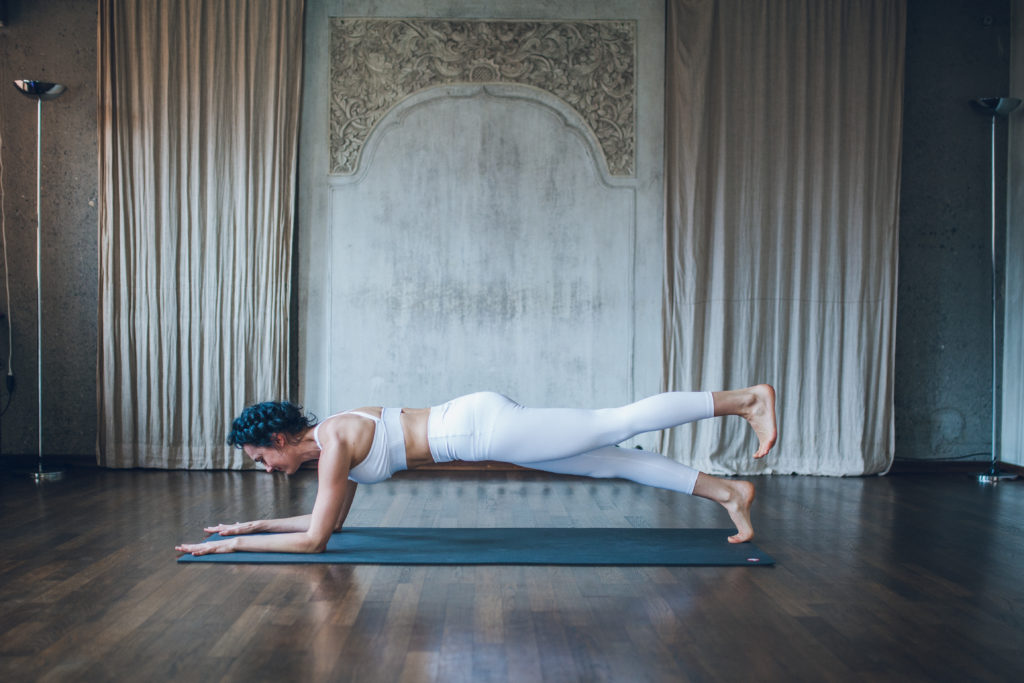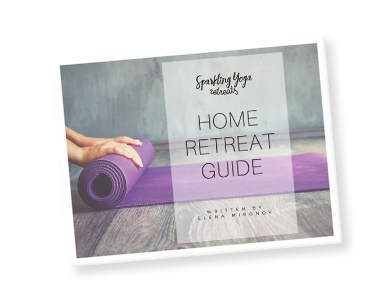Ayurveda Winter Guide Part II - 5 Yoga Poses to Keep You Warm
This post is a continuation of what we've started a few weeks ago - taking you step-by-step through yogic and Ayurvedic strategies of thriving this Winter.
As Winter season sets in, Vata and Kapha influences are dominating the outside weather.
Vata is a combination of Air and Space elements that in excess can make you feel unsteady in your moods and the way you feel. The main qualities of Vata are cold and dry, so to pacify it you want to introduce the poses that make you warm and maybe even induce light sweat. Another way to calm Vata down is to slow down - take the time to rest and meditate, or even take a warm bath.
Kapha is a combination of Water and Earth elements that in excess can make you feel heavy, sluggish and unmotivated. A strategy to pacify excessive Kapha would be to add warming, active poses into your yoga arsenal this Winter, especially when the weather is foggy or it snows or rains (this usually exacerbates Kapha).
So the combination of amazing yoga poses I've prepared for you below will help you deal with both Kapha and Vata, staying warm, healthy, strong and energised this Winter season.
Enjoy!
1. Utkatasana - Chair Pose

Benefits
This amazing pose will definitely ignite your inner fire! Did you know that this pose actually has nothing to do with a chair? „Utkata“ means „fierce“ or „intense". Add this warming yoga pose to your daily routine and you will not only feel the warming effects in your body, but at the same time you'll be strengthening your thighs, hip flexors and back muscles.
Utkatasana stimulates your heart, abdominal organs and diaphragm, thus making it a great choice of asana to keep your agni going strong.
How to
- Start in Tadasana, mountain pose. On an in inhale, raise your arms towards the ceiling.
- On your exhale, bend your knees, try to bring your thighs parallel to the floor, or as close to parallel as you can. Your knees will come out a bit over your feet, however you should still be able to see the tips of your toes. Keep your inner thighs engaged and parallel to each other.
- Keep your shoulders blades relaxed and down your back. Tuck your tailbone down and keep your back long.
- You can stay here for a couple of cycles of breath. To come out, straighten your knees on an inhale, and exhale to release your arms back down into Tadasana.
2. Lolasana - Pendant Pose


Benefits
Lolasana is as much about your core as it is about your arms and shoulders. As you engage your abdominal muscles to keep you in the pose, your digestive organs are stimulated. The post boosts energy levels and is known to increase focus and concentration. Energetically, lolasana is thought to activate the muladhara chakra (root) and manipura chakra (solar plexus). Activating these energy centers will help feel more confident and ready to get through even the coldest Winter days!
Are you new to Lolasana practice? Don’t give in and use blocks for support. And remember the Bhagavad Gita saying that is applicable to every practice: „On this path no effort is wasted, no gain is ever reversed“
How to
1. Start in seated position and cross your ankles to sit on your heels, placing your hands next to your tibia on the floor. First, start by pressing into your hands to lift up the pelvis and leaving your feet on the ground. Just give it a try to get a feeling for it. Then change the crossings of your ankles and try again.
2. Then, start lifting your pelvis and try to lift one foot at a time. Repeat on both sides.
3. To lift both feet at the same time, you want to focus on keeping your abdominal muscles engaged and your bandhas active. This will help you eventually lift off the floor. Before lifting off both feet at the same time, imagine curling into a ball with your torso and your bent legs (keep your ankles crossed), then imagine you are lifting this ball up from the floor with the help of your arms and hands. If you can lift both feet, you will be swinging in between your arms!
4. Repeat with you ankles crossed the other way.
3. Parivrtta Utkata Konasana - Revolved Goddess Pose


Benefits
This asana combines the benefits of goddess pose (grounding, stabilizing and energizing) with the benefits of a twist. Twists are a great way to help your digestive system work at its best as you give your digestive organs a gentle „massage“ while being in the pose. Energetically, this asana harmonizes water and earth elements within our body. Revolved goddess pose balances out the Sacral Chakra (Swadisthana Chakra), boosting creativity and a sense of feeling „at home“ in your body. On a physical level, twisted goddess pose works your upper back muscles, opens your hips and strengthens your psoas muscles.
How to
1. From standing, point your toes out at 45°, bend your knees and squat down, until your knees come out over your toes.
2. To come deeper into the squat, rotate your inner thighs outwards.
3. Place the hands on your knees and keep your spine long, draw your tailbone down. On an exhale, twist the torso to the right, bringing the right shoulder back and left shoulder forward. Keep your gaze over the shoulder. Stay here for 2-3 deep breaths.
4. To exit, bring your ganz back to center, followed by your shoulders. Then twist to the left, and repeat on the left side.
5. Repeat 3 times on each side for maximum benefits of the pose.
4. Parivrtta Adho Mukha Svanasana - Twisted Down-Dog

Benefits
This variation of the well-known downward-facing dog calms the brain, relieves stress and energizes the body. It is a great way to stretch shoulders, neck, hamstrings and calves. The twists supports natural detoxification as it stimulates the digestive organs and is also known to help with sinusitis. On an energetic level, this asana balances out Vata influences. Adho Mukha Svanasana opens the Crown Chakra (Sahasrara), Third Eye Chakra (Ajna) and Heart Chakra (Anahata).
How to
1. Start in downward-facing dog. Spread your fingers wide and press firmly into the mat with your palms and finger to distribute your weight evenly. Reach your pelvis towards the ceiling, draw your sits bones towards the back wall and gently straighten your legs, without locking your knees.
2. On an inhale, lift your left hand and reach underneath your torso and around to your right thigh or ankle, your waist and torso follow the twist to the right.
3. You can turn your head to ganze underneath your right arm. If this is uncomfortable to you, you can turn your ganz up to the ceiling.
4. Stay in this twisted position for about 5-10 breaths. To release, un-twist and replace your left hand to the mat, coming back into to downward-facing dog.
5. Repeat on the other side.
5. Eka Pada Phalakasana - One Legged Plank Pose

Benefits
This variation of plank pose is great to switch things up in your daily routine, adding a challenge to your core, quads and arms. Practicing this asana, will help you feel warm from the inside, as you fire up your core. One legged plank is a powerful way to open your solar plexus chakra and is a great mood & confidence booster, perfect to brighten up any grey and foggy day.
How to
1. Start in high plank and align your shoulders over your wrists while keeping your core engaged, to avoid slouching the back.
2. Push the ground away from you, slightly protract your arms and shoulders, keeping your gaze just in front of you.
3. Lift the right leg to about hip height and keep holding your plank strong as you breath deeply.
4. Make sure to keep your neck long and your spine straight.
5. Release, and switch sides.
Complete this calming practice with 15-30 minutes on practicing yoga nidra - one of the most effective meditations to help you de-stress, calm down, slow down your mental chatter and prepare for sleep.

